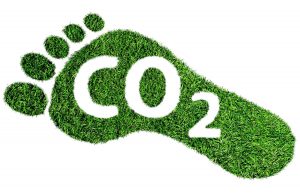We’ve all heard about carbon dioxide – a naturally occurring heat-trapping gas (think respiration). But too much of anything is usually not good. Carbon dioxide, also known as CO2, is the leading culprit behind the greenhouse gases (GHGs) that are warming our planet and contributing to climate change.
There are lots of confusing “carbon” terms in the news these days. In fact, CO2 is just the starting point when it comes to understanding the implications for our world and the many business risks of climate change.
Let’s look at 12 carbon terms to see what they mean, how they relate to each other, and why they’re important.
Carbon footprint
Individuals have a carbon footprint – and so do businesses, industries and governments. In business, the term “carbon footprint” refers to the measurement of the carbon emissions a product, service or action has over its lifetime. Measurement literally correlates to footprint size – so, the bigger the foot, the larger the carbon impact. Carbon footprints are typically expressed as kilograms of CO2.
Businesses can use analytics to understand (and reduce) the carbon impacts of their products and services over their life cycles. For the less technically savvy, the US Environmental Protection Agency has developed a handy calculator to convert energy emissions or energy data into terms that are easy to understand.
Understanding carbon emissions
A reduction of 13,000 pounds per day in carbon emissions is equivalent to GHGs from more than 54,000 miles driven in an average passenger vehicle. Another comparison: It's equivalent to the CO2 emissions from 2,433 gallons of gasoline consumed. Check this EPA calculator to see more examples.
Carbon neutral
The term “carbon neutral” refers to balancing out net carbon inputs and outputs. For example, think about burning a pile of wood. This activity adds a specific amount of carbon to the atmosphere. But if vegetation removes the same amount of carbon, there’s a carbon-neutral effect – because the carbon emitted and absorbed from the atmosphere is equal.
Businesses often work to be “carbon neutral” or achieve “net-zero” carbon emissions. Net-zero means, basically, that no carbon was emitted from the start of an activity.
SAS, along with other companies, is committed to the Paris Agreement. This agreement was signed by many organizations that want to significantly limit global temperature rise. SAS has committed to achieving net-zero carbon emissions by 2050.

Carbon labeling
These days, some companies are using “carbon labels” (part of a product label) to display the GHGs associated with producing their goods. Over time, as more consumers evaluate whether the products they’re buying are “green,” labeling is likely to become much more common.
Check out Carbon Trust to learn more about carbon footprint measurement and analysis.
Carbon pools, sinks and stock
Before we look closer at carbon markets and related terms that focus on the economic side of carbon, it’s helpful to understand a few concepts:
- Carbon pool refers to a storage reservoir of carbon.
- Carbon sink is a storage system that causes net removal of greenhouse gases from the atmosphere.
- Carbon stock refers to the quantity of carbon held in any given carbon pool at a specific point in time.
Carbon credits and carbon offsets
- A carbon credit is a permit for emitting an agreed-upon amount of CO2 (or its equivalent). Usually, one credit allows emissions of one ton of CO2. The amount of carbon credit a company has is often reduced over time as the company works toward carbon neutrality. Those who wind up with extra carbon credits can sell those credits to other organizations that are producing too much carbon.
- Carbon offset programs provide a formal way for businesses (or people, individually) to counter their own carbon emissions. Effectively, it’s a way to balance out or negate the amount of carbon you emit by reducing them somewhere else. For example, you could invest in energy efficiency, renewable energy, or other low-carbon technology programs that reduce GHGs.
The carbon market and carbon trading
So, what do we mean when we talk about the carbon market in general? Basically, it refers to a market-driven method that businesses and governments use to manage emissions and reduce the impact of GHGs. The idea is that a participant in the carbon market could benefit financially by reducing their emissions.
There are two basic types of carbon markets:
- The mandatory market is governed by local, regional or national regulations.
- The voluntary market is less rigid. Businesses that participate in a voluntary carbon market set their own goals for carbon emissions, methods, timelines, etc.
The carbon market also involves carbon trading – something that happens when multiple organizations buy and sell carbon credits.
Carbon budget and carbon taxes
A carbon budget measures carbon inputs and outputs for a particular activity. Similarly, energy accounting measures value by the energy input that’s required for a good or service. Carbon taxes, on the other hand, are a surcharge on fossil fuels – with the aim of reducing carbon dioxide emissions.
Many businesses rely on international (ISO) standards to gauge and report on (or account for) their carbon footprints.
Why now?
The market impacts of climate change and related high-carbon emissions are far-reaching. There are implications for resource productivity, like declining agricultural yields and increased conflict. There are effects on earth’s natural capital, like shortages of all-important water. And there are damages to human-built structures, like beach houses that erode because of coastal flooding tied to rising sea levels.
Lenders, insurance companies and investors have already started to price loans, insurance policies and securities for climate risk factors. Over time, we’ll see even more implications for the business world related to rising carbon emissions and our changing environment. Now is the time to build an understanding of the important carbon terms that have started to define our future.
Analytics and AI are combating deforestation in the Amazon. Learn how this is helping secure the rainforest’s key role in absorbing CO2.



